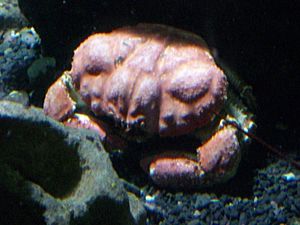Tasmanian giant crab facts for kids
Quick facts for kids Tasmanian giant crab |
|
|---|---|
 |
|
| male | |
| Scientific classification | |
| Synonyms | |
|
Cancer gigas Lamarck, 1818 |
The Tasmanian giant crab, also known as Pseudocarcinus gigas, is a truly enormous crab. Some people call it the giant deepwater crab or queen crab. It is one of the biggest crabs in the world!
This amazing creature lives on the bottom of the ocean. You can find it off the coast of Southern Australia. It is the only type of crab in its special group, called Pseudocarcinus.
Contents
Where the Giant Crab Lives
The Tasmanian giant crab makes its home on rocky and muddy parts of the ocean floor. It lives off the coast of Southern Australia, especially near the edge of the continental shelf.
These crabs can be found in very deep water. They live at depths from about 20 meters (65 feet) down to 820 meters (2,690 feet). That's deeper than many tall buildings!
They move around depending on the season. In summer, they are often found between 110 and 180 meters deep. In winter, they go deeper, usually between 190 and 400 meters. They like water that is cool, preferring temperatures from 12 to 14 degrees Celsius (54 to 57 degrees Fahrenheit).
What the Giant Crab Looks Like

The Tasmanian giant crab is one of the largest crabs on Earth. It can weigh as much as 17.6 kilograms (38.8 pounds). That's like carrying a large dog! Its shell, called a carapace, can be up to 46 centimeters (18 inches) wide.
Only the Japanese spider crab can weigh more than the Tasmanian giant crab. It's truly a giant among crabs!
Male crabs are much bigger than females. Males can grow to be more than twice the size of females. Female crabs usually weigh no more than 7 kilograms (15 pounds).
One special thing about male Tasmanian giant crabs is their claws. They have one normal-sized claw and one super-sized claw. This huge claw can be even longer than their body shell! Female crabs have two normal-sized claws.
The color of these crabs is also interesting. Their underside is usually whitish-yellow. Their top shell is a bright red. The very tips of their claws are black. Younger, smaller crabs have a spotted pattern of yellow and red on their top shell.
Giant Crab Behavior and Life Cycle
The Tasmanian giant crab is a scavenger and a hunter. It eats dead animals that sink to the ocean floor. It also hunts slow-moving creatures. These include snails, other crabs, and starfish. Sometimes, these crabs even eat each other!
Breeding happens in June and July. The female crab carries a huge number of eggs, from 500,000 to 2 million! She holds onto these eggs for about four months.
When the eggs hatch, tiny baby crabs, called larvae, float in the ocean currents. They drift for about two months. After this time, they settle down onto the ocean floor.
These crabs grow very slowly and live a long time. Young crabs shed their shell (moult) every three to four years. Adult female crabs moult only about once every nine years. This slow moulting means they don't breed very often. Mating can only happen right after a crab has shed its old shell, when its new shell is still soft.
Fishing for Giant Crabs
People have been fishing for Tasmanian giant crabs in Tasmania since 1992. Rules were put in place in Australia in 1993 to protect them, including a minimum size for crabs that can be caught.
Fishermen usually catch these crabs using special pots. They drop these pots into the water, usually deeper than 140 meters (460 feet).
Because these crabs grow slowly and live a long time, they can be easily overfished. This means too many could be caught, making it hard for their numbers to recover. To help protect them, the total amount of crabs allowed to be caught was changed in 2004 to 62.1 tonnes (137,000 pounds).
In 2005, 25 different fishing boats were trying to catch these crabs. The total value of the crabs caught that year was about A$2 million. Before being sent to other countries, these crabs are sometimes kept alive in tanks. The water in these tanks is kept cool, between 10 and 14 degrees Celsius (50 to 57 degrees Fahrenheit).
See also
 In Spanish: Pseudocarcinus gigas para niños
In Spanish: Pseudocarcinus gigas para niños

